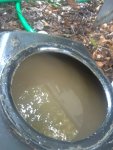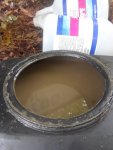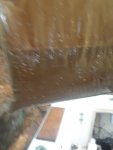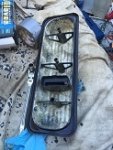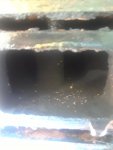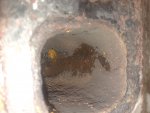Hello. I had a Volvo penta 5.0gi which i teplaced last year with a new Crusader long block 5.7 last year switching over some of my Volvo parts such as manifolds and risers as they were only one season old.
After the initial break in season i winterized the boat and noticed throughout the winter there was a slight pudding of coolant (fresh water half system) right around the thermostat housing. I thought the worst as it was an extremely cold and brutal winter and my first time winterizing this particular engine.
fast forward to spring... I put the boat back into commission. Never saw any more coolant leak out of anywhere nor did I have to add any. The boat ran fine all summer. I religiously check the oil before starting every time and color and levels of oil all looked fine. Coolant level remained consistent. I put 65 hours on it this summer and added maybe a half quart of oil.
So I go to winterize it this year and the oil comes out a muddy brown color. Ill try to attach a picture. I've seen water in oil before in my gear oil and it was white like milky... it his is more brown like chocolate milk which leads me to believe it is coolant? Anyone?
So I have multiple questions here. If it is coolant that would suggest head gasket or cracked block or head. I'm trying to remain optimistic in this since I don't know how the head or block could crack if it hasn't been below freezing yet. I'm also wondering how to go about trouble shooting this. I know compression test and leakdown test. I'm fine with doing the leakdown but I don't want to run a compression test for several reasons... mostly because I have the boat winterized now and I don't want to run it up to temp. I've changed the Oil, fogged it with non ethanol fuel, drained the raw water and ran it to pump antifreeze into the raw water side. After doing this the oil was muddy again so I pumped all of it out and I'm going to put fresh oil back into it but I don't want to run it and contaminate the fresh oil again until I'm ready to dive into this to find the problem.... probably in the spring.
That being said, does anyone have any suggestions on what I can do in the mean time to troubleshoot without starting it? Any ideas on what may have caused coolant to get into the oil? Or am i wrong in assuming iy is coolant? If its raw water yake off the risers and look for water intrusion? Leakdown test? Possibly an intake manifold gasket? Should I squirt some mmo down the spark plug holes to get through the winter?
One last note... when running on the muffs I was trying to get it up yo temperature before changing the oil... it didn't seem to want to get above 160. Normally runs around 170-175. I waited a minute but didn't really think much of it and figured it was warm enough to get the oil out. I'm not sure if this has anything to do with it or not but I'm just trying to give as much information as possible to see if there are any ideas. One last thing.... periodically throughout the season it wouldn't start... as if the engine lost its fuel prime... I could get it started by dumping some fuel down the carb. Once it started it was fine and would be fine on a restart. Again not sure if this has anything to do with it... just throwing it all out there.
Any input is greatly appreciated!
After the initial break in season i winterized the boat and noticed throughout the winter there was a slight pudding of coolant (fresh water half system) right around the thermostat housing. I thought the worst as it was an extremely cold and brutal winter and my first time winterizing this particular engine.
fast forward to spring... I put the boat back into commission. Never saw any more coolant leak out of anywhere nor did I have to add any. The boat ran fine all summer. I religiously check the oil before starting every time and color and levels of oil all looked fine. Coolant level remained consistent. I put 65 hours on it this summer and added maybe a half quart of oil.
So I go to winterize it this year and the oil comes out a muddy brown color. Ill try to attach a picture. I've seen water in oil before in my gear oil and it was white like milky... it his is more brown like chocolate milk which leads me to believe it is coolant? Anyone?
So I have multiple questions here. If it is coolant that would suggest head gasket or cracked block or head. I'm trying to remain optimistic in this since I don't know how the head or block could crack if it hasn't been below freezing yet. I'm also wondering how to go about trouble shooting this. I know compression test and leakdown test. I'm fine with doing the leakdown but I don't want to run a compression test for several reasons... mostly because I have the boat winterized now and I don't want to run it up to temp. I've changed the Oil, fogged it with non ethanol fuel, drained the raw water and ran it to pump antifreeze into the raw water side. After doing this the oil was muddy again so I pumped all of it out and I'm going to put fresh oil back into it but I don't want to run it and contaminate the fresh oil again until I'm ready to dive into this to find the problem.... probably in the spring.
That being said, does anyone have any suggestions on what I can do in the mean time to troubleshoot without starting it? Any ideas on what may have caused coolant to get into the oil? Or am i wrong in assuming iy is coolant? If its raw water yake off the risers and look for water intrusion? Leakdown test? Possibly an intake manifold gasket? Should I squirt some mmo down the spark plug holes to get through the winter?
One last note... when running on the muffs I was trying to get it up yo temperature before changing the oil... it didn't seem to want to get above 160. Normally runs around 170-175. I waited a minute but didn't really think much of it and figured it was warm enough to get the oil out. I'm not sure if this has anything to do with it or not but I'm just trying to give as much information as possible to see if there are any ideas. One last thing.... periodically throughout the season it wouldn't start... as if the engine lost its fuel prime... I could get it started by dumping some fuel down the carb. Once it started it was fine and would be fine on a restart. Again not sure if this has anything to do with it... just throwing it all out there.
Any input is greatly appreciated!




















